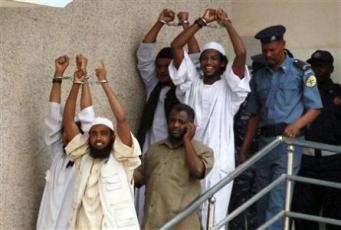U.S. believed killers of USAID employee in Sudan received inside help to escape: ex-official
January 9, 2013 (WASHINGTON) – The United States had intelligence suggesting that four men sentenced to death over the 2008 assassination of a USAID employee in Sudan in were assisted in their escape by officials inside the maximum-security prison they were kept in, a former U.S. official said.
 The four convicts whose names were Mohamed Makkawi, Abdel-Basit Haj al-Hassan, Mohannad Osman Youssef, Abdel-Ra’uf Abu-Zaid Mohamed Hamza and Murad Abdel-Rahman Abdullah appeared on a YouTube video released last month detailing their escape plan from Kober prison in the summer of 2010.
The four convicts whose names were Mohamed Makkawi, Abdel-Basit Haj al-Hassan, Mohannad Osman Youssef, Abdel-Ra’uf Abu-Zaid Mohamed Hamza and Murad Abdel-Rahman Abdullah appeared on a YouTube video released last month detailing their escape plan from Kober prison in the summer of 2010.
They claimed to have dug a 38 meters (125 feet) tunnel through the floors of a kitchen room all the way to outside the prison walls. Portions of the video were filmed in broad daylight from inside the prison and a footage of the tunnel was shown.
The Sudanese government later re-arrested Hamza while the family of Youssef said he was killed in Somalia without giving details.
“We thought it was highly unlikely,” the former US. official told Sudan Tribune when asked about whether Washington at the time believed the convicts could have simply done on their own.
The official who spoke on condition of anonymity in order to freely discuss intelligence matters said that Washington later obtained information that the prisoners received inside help from prison guards.
What the U.S. did not have was evidence linking anyone in the Sudanese government to the assisted escape even though they had “great suspicion” that this was the case.
The four Sudanese men, described as “Islamic extremists” by the prosecution, were charged with the killing of John Granville, of the U.S. Agency for International Development (USAID), and his driver, Abdurrahman Abbas Rahma on 2008 New Years Eve.
On Tuesday the U.S. announced that it is offering a total of $10 million for information leading to the arrest of two remaining fugitives who remain at large.
The ex-U.S. official said the killing of their diplomat highlighted the formidable intelligence challenges when it came to assessing terrorism risks in Sudan.
“This [assassination incident] wasn’t expected. We had no information on a specific threat” said the official who intimately involved in Sudan matters over the last decade.
“We had very little access to Sudan and very few operatives [on the ground] so we had to rely on the host government,” the official said.
The Sudanese National Intelligence and Security Services (NISS) he said was “far more concerned with political risks versus terrorism risks” making it extremely difficult for the U.S. to view them as reliable.
Furthermore the NISS did not have monitoring capabilities, adding that even though the spy agency may appear sophisticated by Sudan’s standards the intelligence community in the U.S. did not view them so.
Asked whether Washington provided them with tools to upgrade their capabilities in the context of the counterterrorism cooperation that existed, he said that a decision was made not to do so.
“We provided them very little technical support out of concern that it could be used against their political foes,” the official said.
He also strongly cautioned against exaggerating the level of intelligence cooperation that was in place between NISS and the U.S. as suggested by media reports since the terrorist attacks on Washington and New York in September 2001.
“It is true that there was a period of time as in 2002, 2003 and 2004 when intelligence cooperation with NISS went up but that has to be put in context….It is relative as it [counterterrorism ties] went from nothing to something” the official said.
He said that the U.S. intelligence cooperation with Sudan is nowhere near the one that exists with Jordan for example.
The intelligence cooperation between the U.S. and Sudan was publicly exposed in 2005 when the Los Angeles Times disclosed that the Central Intelligence Agency (CIA) sent a jet in April 2005 to Khartoum to ferry former NISS chief Salah Gosh into Washington for meetings.
The same newspaper revealed in 2007 that Sudan has secretly worked with the CIA to spy on the insurgency in Iraq despite the strained relations with Washington over the Darfur crisis.
Ironically Sudan has been under the U.S. blacklist of states sponsoring terrorism since 1993 on allegations of harboring Islamist militants.
Sudan is also subject to comprehensive economic sanctions since 1997 over terrorism charges as well as human right abuses. Further sanctions, particularly on weapons, have been imposed since the 2003 outbreak of violence in the western Darfur region.
The Sudanese government did not allow U.S. investigators to get access to the four men and were only briefed verbally by an NISS official on the outcome of the interrogations, the official said.
The U.S. was interested in finding what the capacity of those behind the assassination and the kind of funding they received as well as the links they had, he said.
Sudan on the other hand did not move on the terrorist cell out of making the U.S. happy but rather out of concern that there is an unknown group inside the country that could pose a potential threat to the regime.
The U.S. nonetheless provided Sudan with vital intelligence that enabled them to nab the culprits behind the assignation of the USAID official.
“They looked where we told them to look,” the official said without elaborating.
(ST)
